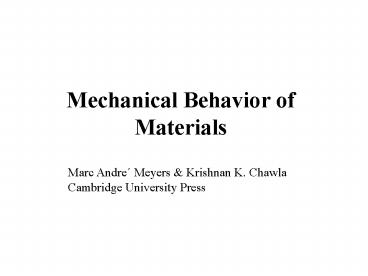Mechanical Behavior of Materials - PowerPoint PPT Presentation
Title:
Mechanical Behavior of Materials
Description:
Biomaterial: Toucan Beak (a) Toucan beak; (b) external shell made of ... found in the inside of toucan beak.(Courtesy of M. S. Schneider andK. S. Vecchio. ... – PowerPoint PPT presentation
Number of Views:302
Avg rating:3.0/5.0
Title: Mechanical Behavior of Materials
1
Mechanical Behavior of Materials
Marc Andre Meyers Krishnan K. Chawla Cambridge
University Press
2
Chapter 1 Materials, Structure, Properties, and
Performance
3
Thomass Iterative Tetrahedron
4
Properties of 3 Main Classes of Materials
5
Biological Materials Dental Implants in the
Jawbone
6
Biological Materials Typical Hip and Knee
Prostheses
(a) Total hip replacement prosthesis (b) total
knee replacement prosthesis.
7
Composites
- Schematic representations of different classes of
composites. - (b) Different kinds of reinforcement in
composite materials. Composite with continuous
fibers with - four different orientations
8
Modulus and Strength in Materials
9
Hierarchical Structure
10
Crystal Structure
11
Miller Indices
12
Hexagonal Structure
13
Metallic Structures
14
FCC and HCP Structures
(a) Layer of most closely packed atoms
corresponding to (111) in FCC and (00.1) in HCP.
(b) Packing sequence of most densely packed
planes in AB and AC sequence. (c) Photograph of
ball model showing the ABAB sequence of the
HCP structure. (d) Photograph of ball model
showing the ABCABC sequence of the FCC
structure.
15
Different Structures of Ceramics
16
Structure of Glasses
- Ordered crystalline of silica
- Random-network
- glassy of silica
(c) Specific Volume vs. temperature for
glassy and crystalline forms of material
(c)
(d) (e) Atomic arrangements in crystalline
and glassy metals
(d)
(e)
17
Classification of Polymers
(a) Homopolymer one type of repeating unit. (b)
Random copolymer two monomers, A and B,
distributed randomly. (c) Block copolymer
a sequence of monomer A, followed by a
sequence of monomer B. (d) Graft copolymer
Monomer A forms the main chain, while
monomer B forms the branched chains.
Different types of molecular chain configurations.
18
Tacticity in Polypropylene
Tacticity, or the order of placement of side
groups.
19
Crystallinity of Polymers
(a) Electron micrograph of a lamellar
Crystal showing growth spirals around screw
dislocation
(a)
- Spherulitic structures
- Typical form of spherulitic structure
- Each having radially
- arranged narrow crystalline
- lamellae
- Each lamella has tightly packed
- polymer chains folding back and forth
20
Polymer Chain Configuration
21
Molecular Weight and Chain Distribution
A schematic molecular weight distribution curve.
Various molecular weight parameters are indicated.
22
Liquid Crystals
Different types of order in the liquid
crystalline state.
23
Mechanical Behavior of Biological Materials
Stressstrain curves for biological materials.
(a) Urether. (After F. C. P. Yin and Y. C. Fung,
Am. J. Physiol. 221 (1971), 1484.) (b) Human
femur bone. (After F. G. Evans, Artificial Limbs,
13 (1969) 37.)
24
Crack Propagation in a Abalone Shell
(a) Cross section ofabalone shell showing how a
crack, starting at left, is deflected
byviscoplastic layer between calcium carbonate
lamellae (mesoscale). (b) Schematic drawing
showing arrangement of calcium carbonate in
nacre, forming a miniature brick and mortar
structure (microscale).
25
Porous and Cellular Materials
- Compressive stressstrain curves for foams.
- Polyethylene with different initial densities.
- Mullite with relative density Px/Ps 0.08.
(Adapted from L. J. Gibson and M. F. Ashby,
Cellular Solids Structure and Properties
(Oxford, U.K. Pergamon Press, 1988), pp. 124,
125.) - Schematic of a sandwich structure.
26
Biomaterial Toucan Beak
Cellular materials (a) synthetic aluminium foam
(b) foam found in the inside of toucan
beak.(Courtesy of M. S. Schneider andK. S.
Vecchio.)
(a) Toucan beak (b) external shell made of
keratin scales.
27
Biomaterials Atomic Structure
Atomic structure of hydroxyapatite small white
atoms (P), large gray atoms (O), black atoms
(Ca). (b) Atomic structure of aragonite large
dark atoms (Ca), small gray atoms (C),
large white atoms (O).
28
Amino Acids
29
DNA Structure
30
Collagen
Triple helix structure of collagen. (Adapted from
Y. C. Fung, Biomechanics Mechanical properties
of Living Tissues (Berlin Springer, 1993).)
Hierarchical organization of collagen, starting
with triple helix, and going to fibrils. (From H.
Lodish et al., Molecular Cell Biology, 4th ed.
(New York, W.H. Freeman Company, 1999).)
31
Mechanical Properties of a Collagen Fiber
Idealized configuration of a wavy collagen fiber.
Stressstrain curve of collagen with three
characteristic stages.
32
Muscle Fiber
Molecular structure of (a) actin and (b) myosin
(c) action of cross-bridges when actin filament
is moved to left with respect to myosin filament
notice how cross-bridges detach themselves, then
reattach themselves to actin.
33
Muscle Structure
34
Biomaterial Sponge Spicule
SEM of fractured sponge spicule showing
two-dimensional onion-skin structure of
concentric layers. (Courtesy of G Mayer and
M. Sarikaya.)
Stress-deflection responses of synthetic silica
rod and sponge spicule in flexuretesting.
(Courtesy of M. Sarikaya and G. Mayer.)
35
Active (smart) Materials
- s -stress
- P-polarization
- e-strain
- E-electric field
- d- polarizability tensor
(a) Effect of applied field E on dimension of
ferroelectric material. (b) Linear relationship
between strain and electric field. (Courtesy of
G. Ravichandran.)
36
Electronic Materials
Cross section of a complementary
metal-oxide semiconductor (CMOS). (Adapted from
W. D. Nix, Met. Trans., 20A (1989) 2217.)
37
Nanomaterials Carbon Nanotubes
Array of parallel carbon nanotubes grown as
a forest. (From R. H. Baughman, A. A. Zakhidov
and W. A. de Heer, Science, 297 (2002) 787.)
Three configurations for single wall carbon
nanotubes (a) arm chair (b) zig-zag
(c)chiral.(Adapted from M. S. Dresselhaus, G.
Dresselhaus, and R. Saito, Carbon, 33 (1995) 883.)

